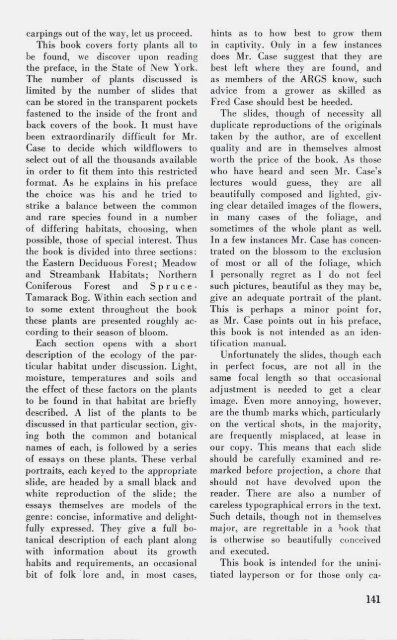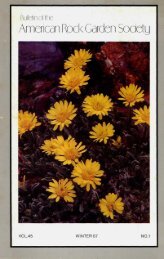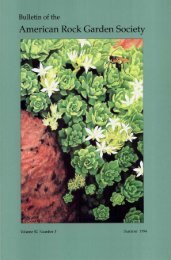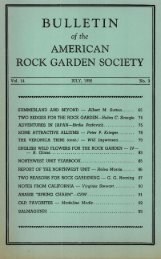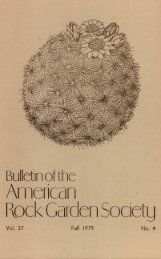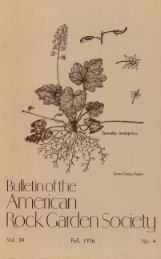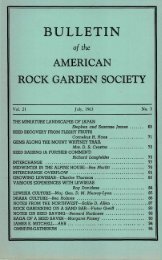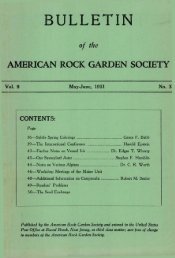Bulletin - Summer 1979 - North American Rock Garden Society
Bulletin - Summer 1979 - North American Rock Garden Society
Bulletin - Summer 1979 - North American Rock Garden Society
You also want an ePaper? Increase the reach of your titles
YUMPU automatically turns print PDFs into web optimized ePapers that Google loves.
carpings out of the way, let us proceed.This book covers forty plants all tobe found, we discover upon readingthe preface, in the State of JNew York.The number of plants discussed islimited by the number of slides thatcan be stored in the transparent pocketsfastened to the inside of the front andback covers of the book. It must havebeen extraordinarily difficult for Mr.Case to decide which wildflowers toselect out of all the thousands availablein order to fit them into this restrictedformat. As he explains in his prefacethe choice was his and he tried tostrike a balance between the commonand rare species found in a numberof differing habitats, choosing, whenpossible, those of special interest. Thusthe book is divided into three sections:the Eastern Deciduous Forest; Meadowand Streambank Habitats; <strong>North</strong>ernConiferous Forest and Spruce-Tamarack Bog. Within each section andto some extent throughout the bookthese plants are presented roughly accordingto their season of bloom.Each section opens with a shortdescription of the ecology of the particularhabitat under discussion. Light,moisture, temperatures and soils andthe effect of these factors on the plantsto be found in that habitat are brieflydescribed. A list of the plants to bediscussed in that particular section, givingboth the common and botanicalnames of each, is followed by a seriesof essays on these plants. These verbalportraits, each keyed to the appropriateslide, are headed by a small black andwhite reproduction of the slide; theessays themselves are models of thegenre: concise, informative and delightfullyexpressed. They give a full botanicaldescription of each plant alongwith information about its growthhabits and requirements, an occasionalbit of folk lore and, in most cases,hints as to how best to grow themin captivity. Only in a few instancesdoes Mr. Case suggest that they arebest left where they are found, andas members of the ARGS know, suchadvice from a grower as skilled asFred Case should best be heeded.The slides, though of necessity allduplicate reproductions of the originalstaken by the author, are of excellentquality and are in themselves almostworth the price of the book. As thosewho have heard and seen Mr. Case'slectures would guess, they are allbeautifully composed and lighted, givingclear detailed images of the flowers,in many cases of the foliage, andsometimes of the whole plant as well.In a few instances Mr. Case has concentratedon the blossom to the exclusionof most or all of the foliage, whichI personally regret as I do not feelsuch pictures, beautiful as they may be,give an adequate portrait of the plant.This is perhaps a minor point for,as Mr. Case points out in his preface,this book is not intended as an identificationmanual.Unfortunately the slides, though eachin perfect focus, are not all in thesame focal length so that occasionaladjustment is needed to get a clearimage. Even more annoying, however,are the thumb marks which, particularlyon the vertical shots, in the majority,are frequently misplaced, at lease inour copy. This means that each slideshould be carefully examined and remarkedbefore projection, a chore thatshould not have devolved upon thereader. There are also a number ofcareless typographical errors in the text.Such details, though not in themselvesmajor, are regrettable in a book thatis otherwise so beautifully conceivedand executed.This book is intended for the uninitiatedlayperson or for those only ca-141


